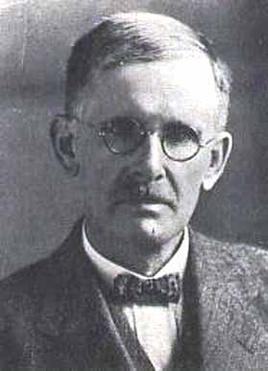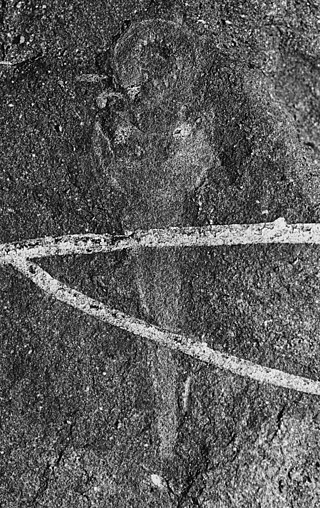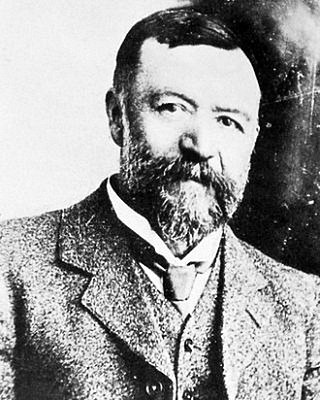Pterosaurs
New taxa
| Taxon | Novelty | Status | Author(s) | Age | Unit | Location | Notes | Images |
|---|---|---|---|---|---|---|---|---|
| Pterodactylus suevicus [2] | Sp. nov. | Valid | Quenstedt | Kimmeridgian | Nusplinger Schist | Later named Cycnorhamphus suevicus |  | |
| |||
|---|---|---|---|
| +... |
Paleontology or palaeontology is the study of prehistoric life forms on Earth through the examination of plant and animal fossils . [1] This includes the study of body fossils, tracks ( ichnites ), burrows , cast-off parts, fossilised feces ( coprolites ), palynomorphs and chemical residues . Because humans have encountered fossils for millennia, paleontology has a long history both before and after becoming formalized as a science . This article records significant discoveries and events related to paleontology that occurred or were published in the year 1855.
| Taxon | Novelty | Status | Author(s) | Age | Unit | Location | Notes | Images |
|---|---|---|---|---|---|---|---|---|
| Pterodactylus suevicus [2] | Sp. nov. | Valid | Quenstedt | Kimmeridgian | Nusplinger Schist | Later named Cycnorhamphus suevicus |  | |
| Taxon | Novelty | Status | Author(s) | Age | Unit | Location | Notes | Images |
|---|---|---|---|---|---|---|---|---|
| Aptychodon | Gen. nov. | Valid | Reuss | Turonian | Jizeru Formation | A pliosauroid. | ||
| Brimosaurus | Gen. nov. | Valid | Leidy | Late Cretaceous | Unknown | A dubious plesiosauroid. | ||

Andrew Geddes Bain, was a Cape Colony geologist, road engineer, palaeontologist and explorer.

James Hall Jr. was an American geologist and paleontologist. He was a noted authority on stratigraphy and had an influential role in the development of paleontology in the United States.

William Guybon Atherstone was a medical practitioner, naturalist and geologist, one of the pioneers of South African geology and a member of the Cape Parliament.

Makhanda, formerly known as Grahamstown, is a town of about 75,000 people in the Eastern Cape province of South Africa. It is situated about 125 kilometres (80 mi) northeast of Gqeberha and 160 kilometres (100 mi) southwest of East London. It is the largest town in the Makana Local Municipality, and the seat of the municipal council. It also hosts Rhodes University, the Eastern Cape Division of the High Court, the South African Library for the Blind (SALB), a diocese of the Anglican Church of Southern Africa, and 6 South African Infantry Battalion. Furthermore, located approximately 3 km south-east of the town lies Waterloo Farm, the only estuarine fossil site in the world from 360 million years ago with exceptional soft-tissue preservation.

Nqwebasaurus is a basal coelurosaur and is the basal-most member of the coelurosaurian clade Ornithomimosauria from the Early Cretaceous of South Africa. The name Nqwebasaurus is derived from the Xhosa word Nqweba which is the local name for the Kirkwood district, and thwazi is ancient Xhosa for "fast runner". Currently it is the oldest coelurosaur in Africa and shows that basal coelurosaurian dinosaurs inhabited Gondwana 50 million years earlier than previously thought. The type specimen of Nqwebasaurus was discovered by William J. de Klerk who is affiliated with the Albany Museum in Grahamstown. It is the only fossil of its species found to date and was found in the Kirkwood Formation of the Uitenhage Group. Nqwebasaurus has the unofficial nickname "Kirky", due to being found in the Kirkwood.

Groenlandaspis is an extinct genus of arthrodire from the Late Devonian. Fossils of the different species are found in late Devonian strata in all continents except eastern Asia. The generic name commemorates the fact that the first specimens of the type species were found in Greenland.

The Evolutionary Studies Institute (ESI) is a paleontological, paleoanthropological and archeological research institute operated through the Faculty of Science of the University of the Witwatersrand, Johannesburg, South Africa. Previously known as the Bernard Price Institute for Palaeontological Research (BPI) it was renamed the Evolutionary Studies Institute in 2013 to better showcase the scope of its research.

John Hewitt was a South African zoologist and archaeologist of British origin. He was born in Dronfield, Derbyshire, England, and died in Grahamstown, South Africa. He was the author of several herpetological papers which described new species. He also described new species of spiders and other arachnids.
Paleontology or palaeontology is the study of prehistoric life forms on Earth through the examination of plant and animal fossils. This includes the study of body fossils, tracks (ichnites), burrows, cast-off parts, fossilised feces (coprolites), palynomorphs and chemical residues. Because humans have encountered fossils for millennia, paleontology has a long history both before and after becoming formalized as a science. This article records significant discoveries and events related to paleontology that occurred or were published in the year 1957.
Paleontology or palaeontology is the study of prehistoric life forms on Earth through the examination of plant and animal fossils. This includes the study of body fossils, tracks (ichnites), burrows, cast-off parts, fossilised feces (coprolites), palynomorphs and chemical residues. Because humans have encountered fossils for millennia, paleontology has a long history both before and after becoming formalized as a science. This article records significant discoveries and events related to paleontology that occurred or were published in the year 1911.
Paleontology or palaeontology is the study of prehistoric life forms on Earth through the examination of plant and animal fossils. This includes the study of body fossils, tracks (ichnites), burrows, cast-off parts, fossilised feces (coprolites), palynomorphs and chemical residues. Because humans have encountered fossils for millennia, paleontology has a long history both before and after becoming formalized as a science. This article records significant discoveries and events related to paleontology that occurred or were published in the year 1938.
Chagrinia is an extinct genus of prehistoric marine coelacanth which lived during the Late Devonian period.

The Albany Museum, South Africa is situated in Grahamstown in South Africa, is affiliated to Rhodes University and dates back to 1855, making it the second oldest museum in South Africa.

Paleontology in Massachusetts refers to paleontological research occurring within or conducted by people from the U.S. state of Massachusetts. The fossil record of Massachusetts is very similar to that of neighboring Connecticut. During the early part of the Paleozoic era, Massachusetts was covered by a warm shallow sea, where brachiopods and trilobites would come to live. No Carboniferous or Permian fossils are known from the state. During the Cretaceous period the area now occupied by the Elizabeth Islands and Martha's Vineyard were a coastal plain vegetated by flowers and pine trees at the edge of a shallow sea. No rocks are known of Paleogene or early Neogene age in the state, but during the Pleistocene evidence indicates that the state was subject to glacial activity and home to mastodons. The local fossil theropod footprints of Massachusetts may have been at least a partial inspiration for the Tuscarora legend of the Mosquito Monster or Great Mosquito in New York. Local fossils had already caught the attention of scientists by 1802 when dinosaur footprints were discovered in the state. Other notable discoveries include some of the first known fossil of primitive sauropodomorphs and Podokesaurus. Dinosaur tracks are the Massachusetts state fossil.

Priscomyzon riniensis is an extinct lamprey that lived some 360 million years ago during the Famennian in a marine or estuarine environment in South Africa. This small agnathan is anatomically similar to the Mazon Creek lampreys, but is some 35 million years older. Its key developments included the first known large oral disc, circumoral teeth and a branchial basket.

Serenichthys kowiensis is a fossil species of coelacanth described in 2015 from near Grahamstown in South Africa.
Percy W.H. Kettlewell was an English priest and educationist in the early 20th century.

Daniel Rossouw Kannemeyer was a South African medical practitioner, naturalist, archaeologist and palaeontologist, the son of Daniel Gerhardus Kannemeyer and Johanna Susanna Rossouw He is best remembered for his contributions to palaeontology and archaeology although his collections of zoological specimens are greatly valued by the museums which acquired them.

The Bokkeveld Group is the second of the three main subdivisions of the Cape Supergroup in South Africa. It overlies the Table Mountain Group and underlies the Witteberg Group. The Bokkeveld Group rocks are considered to range between Lower Devonian (Lochkovian) to Middle Devonian (Givetian) in age.

The Waterloo Farm lagerstätte is a Famennian lagerstätte in South Africa that constitutes the only known record of a near-polar Devonian coastal ecosystem.